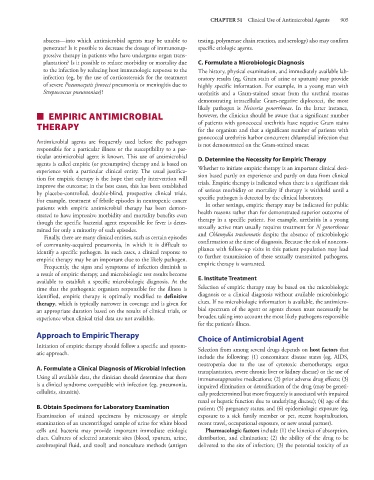Page 919 - Basic _ Clinical Pharmacology ( PDFDrive )
P. 919
CHAPTER 51 Clinical Use of Antimicrobial Agents 905
abscess—into which antimicrobial agents may be unable to testing, polymerase chain reaction, and serology) also may confirm
penetrate? Is it possible to decrease the dosage of immunosup- specific etiologic agents.
pressive therapy in patients who have undergone organ trans-
plantation? Is it possible to reduce morbidity or mortality due C. Formulate a Microbiologic Diagnosis
to the infection by reducing host immunologic response to the The history, physical examination, and immediately available lab-
infection (eg, by the use of corticosteroids for the treatment oratory results (eg, Gram stain of urine or sputum) may provide
of severe Pneumocystis jiroveci pneumonia or meningitis due to highly specific information. For example, in a young man with
Streptococcus pneumoniae)? urethritis and a Gram-stained smear from the urethral meatus
demonstrating intracellular Gram-negative diplococci, the most
likely pathogen is Neisseria gonorrhoeae. In the latter instance,
■ EMPIRIC ANTIMICROBIAL however, the clinician should be aware that a significant number
THERAPY of patients with gonococcal urethritis have negative Gram stains
for the organism and that a significant number of patients with
gonococcal urethritis harbor concurrent chlamydial infection that
Antimicrobial agents are frequently used before the pathogen is not demonstrated on the Gram-stained smear.
responsible for a particular illness or the susceptibility to a par-
ticular antimicrobial agent is known. This use of antimicrobial D. Determine the Necessity for Empiric Therapy
agents is called empiric (or presumptive) therapy and is based on
experience with a particular clinical entity. The usual justifica- Whether to initiate empiric therapy is an important clinical deci-
tion for empiric therapy is the hope that early intervention will sion based partly on experience and partly on data from clinical
improve the outcome; in the best cases, this has been established trials. Empiric therapy is indicated when there is a significant risk
by placebo-controlled, double-blind, prospective clinical trials. of serious morbidity or mortality if therapy is withheld until a
For example, treatment of febrile episodes in neutropenic cancer specific pathogen is detected by the clinical laboratory.
patients with empiric antimicrobial therapy has been demon- In other settings, empiric therapy may be indicated for public
strated to have impressive morbidity and mortality benefits even health reasons rather than for demonstrated superior outcome of
though the specific bacterial agent responsible for fever is deter- therapy in a specific patient. For example, urethritis in a young
mined for only a minority of such episodes. sexually active man usually requires treatment for N gonorrhoeae
Finally, there are many clinical entities, such as certain episodes and Chlamydia trachomatis despite the absence of microbiologic
of community-acquired pneumonia, in which it is difficult to confirmation at the time of diagnosis. Because the risk of noncom-
identify a specific pathogen. In such cases, a clinical response to pliance with follow-up visits in this patient population may lead
empiric therapy may be an important clue to the likely pathogen. to further transmission of these sexually transmitted pathogens,
Frequently, the signs and symptoms of infection diminish as empiric therapy is warranted.
a result of empiric therapy, and microbiologic test results become
available to establish a specific microbiologic diagnosis. At the E. Institute Treatment
time that the pathogenic organism responsible for the illness is Selection of empiric therapy may be based on the microbiologic
identified, empiric therapy is optimally modified to definitive diagnosis or a clinical diagnosis without available microbiologic
therapy, which is typically narrower in coverage and is given for clues. If no microbiologic information is available, the antimicro-
an appropriate duration based on the results of clinical trials, or bial spectrum of the agent or agents chosen must necessarily be
experience when clinical trial data are not available. broader, taking into account the most likely pathogens responsible
for the patient’s illness.
Approach to Empiric Therapy Choice of Antimicrobial Agent
Initiation of empiric therapy should follow a specific and system- Selection from among several drugs depends on host factors that
atic approach.
include the following: (1) concomitant disease states (eg, AIDS,
neutropenia due to the use of cytotoxic chemotherapy, organ
A. Formulate a Clinical Diagnosis of Microbial Infection transplantation, severe chronic liver or kidney disease) or the use of
Using all available data, the clinician should determine that there immunosuppressive medications; (2) prior adverse drug effects; (3)
is a clinical syndrome compatible with infection (eg, pneumonia, impaired elimination or detoxification of the drug (may be geneti-
cellulitis, sinusitis). cally predetermined but more frequently is associated with impaired
renal or hepatic function due to underlying disease); (4) age of the
B. Obtain Specimens for Laboratory Examination patient; (5) pregnancy status; and (6) epidemiologic exposure (eg,
Examination of stained specimens by microscopy or simple exposure to a sick family member or pet, recent hospitalization,
examination of an uncentrifuged sample of urine for white blood recent travel, occupational exposure, or new sexual partner).
cells and bacteria may provide important immediate etiologic Pharmacologic factors include (1) the kinetics of absorption,
clues. Cultures of selected anatomic sites (blood, sputum, urine, distribution, and elimination; (2) the ability of the drug to be
cerebrospinal fluid, and stool) and nonculture methods (antigen delivered to the site of infection; (3) the potential toxicity of an

